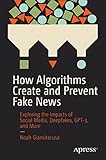How algorithms create and prevent fake news : exploring the impacts of social media, deepfakes, GPT-3, and more / Noah Giansiracusa
Material type: TextLanguage: English Publication details: [Berkeley] : Apress, 2021Description: xii, 235 pages : illustration, portrait ; 24 cmISBN:
TextLanguage: English Publication details: [Berkeley] : Apress, 2021Description: xii, 235 pages : illustration, portrait ; 24 cmISBN: - 9781484271544
- 1484271556
- PN 4766 G434h 2021
| Item type | Current library | Home library | Collection | Shelving location | Call number | Copy number | Status | Barcode | |
|---|---|---|---|---|---|---|---|---|---|
 Libro
Libro
|
Biblioteca Juan Bosch | Biblioteca Juan Bosch | Humanidades | Humanidades (4to. Piso) | PN 4766 G434h 2021 (Browse shelf(Opens below)) | 1 | Available | 00000194967 |
Browsing Biblioteca Juan Bosch shelves, Shelving location: Humanidades (4to. Piso), Collection: Humanidades Close shelf browser (Hides shelf browser)

|

|

|

|

|

|
No cover image available | ||
| PN 4759 H867e 2003 Escribiendo historias : el arte y el oficio de narrar en el periodismo / | PN4759 .I36 1999 La incómoda frontera entre el periodismo y la literatura / | PN 4759 O77r 2014 Relatos para desifrar el mundo: 50 historias puestas al día / | PN 4766 G434h 2021 How algorithms create and prevent fake news : exploring the impacts of social media, deepfakes, GPT-3, and more / | PN 4766 N216s 2019 Social media and the public interest : media regulation in the disinformation age / | PN 4775 A346c 1981 Cómo leer un periódico / | PN 4775 A514r 1963 El reportero. |
Perils of pageview
Crafted by computer
Deepfake deception
Autoplay the autocrats
Prevarication and the polygraph
Gravitating to Google
Avarice of advertising
Social spread
Tools for truth
"From deepfakes to GPT-3, deep learning is now powering a new assault on our ability to tell what's real and what's not, bringing a whole new algorithmic side to fake news. On the other hand, remarkable methods are being developed to help automate fact-checking and the detection of fake news and doctored media. Success in the modern business world requires you to understand these algorithmic currents, and to recognize the strengths, limits, and impacts of deep learning--especially when it comes to discerning the truth and differentiating fact from fiction. This book tells the stories of this algorithmic battle for the truth and how it impacts individuals and society at large. In doing so, it weaves together the human stories and what's at stake here, a simplified technical background on how these algorithms work, and an accessible survey of the research literature exploring these various topics. How Algorithms Create and Prevent Fake News is an accessible, broad account of the various ways that data-driven algorithms have been distorting reality and rendering the truth harder to grasp. From news aggregators to Google searches to YouTube recommendations to Facebook news feeds, the way we obtain information today is filtered through the lens of tech giant algorithms. The way data is collected, labelled, and stored has a big impact on the machine learning algorithms that are trained on it, and this is a main source of algorithmic bias which gets amplified in harmful data feedback loops. Don't be afraid: with this book you'll see the remedies and technical solutions that are being applied to oppose these harmful trends. There is hope"--Publisher's description
There are no comments on this title.

